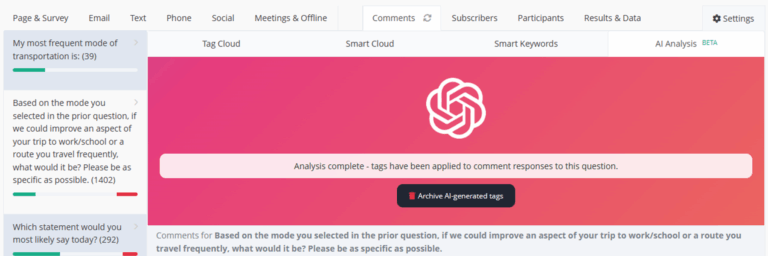What are the benefits of closing the feedback loop?

Closing the feedback loop to report findings is one step in the public engagement process that may be overlooked because of a lack of staff time or bandwidth. After collecting public input and finding key insights, we might often go straight to outlining a plan without following up with residents on how their input may have impacted that plan.
However, there are real benefits to closing the feedback loop, both in the short run and in the long run. The right software can help automate time consuming tasks and make it easier to close the feedback loop, whether creating visual results and reports, posting findings online, or sending a follow-up email.
Below are some success stories that illustrate the real-world benefits of closing the feedback loop.
Provides opportunities to continuously engage residents and increase public participation

Community engagement is a cyclical, dynamic process that should build stronger relationships with residents. Throughout multiple initiatives, GoTriangle continuously closed the feedback loop with residents to increase participation from impacted communities. With well-documented communications and engagement data, GoTriangle was able to clearly tell the story of public feedback and win grant funding:
-
Combining online and traditional engagement methods, GoTriangle reached thousands of residents for feedback on over 50 bus routes.
-
Input data was used to create data visualizations and summary reports to make the large response set understandable to internal stakeholders.
-
Using meaningful data directly from potentially impacted communities, GoTriangle was able to create a draft transit plan, which it then shared with the public and project participants.
-
Contact information gathered in outreach was automatically stored and segmented in a public participation base. With a larger audience of active citizens, GoTriangle re-engaged residents in decisions about Bus Rapid Transit and commuter rail.
-
This follow-up survey received 700 responses, which quantified public sentiment and led to grant funding.
Creates two-way communication and meaningful feedback, every step of the way

When a Major League Soccer team was positioned to move to Austin, the city put a premium on ensuring public feedback would go directly into the negotiations with MLS ownership. Gathering public input and reporting it back to Austin’s citizens was critical in showing that the priorities of its citizens were being taken into account.
-
After an initial survey, Austin created visual reports and embedded them directly into the city’s website.
-
By making it optional to provide an email address when taking the survey, the city was able to let those residents who provided an email (680+) know that the results had been posted and thank them for participating.
-
The city council then took that input from the public and implemented it in their opening negotiations with MLS ownership.
-
Austin offered up a second opportunity for resident input, this time in the form of an online town hall, laying out the initial provisions. During this time, residents were able to elaborate and drill down into the issues that meant the most to them.
-
With this follow-up feedback, the communications team returned to City Council and the economic development team with a thorough understanding of where the community stood.
-
Austin used this feedback, proportionate to concern and interest, directly in the final stages of negotiation with MLS ownership.
Closing the feedback loop builds relationships and public trust
After looking at email engagement data from our work with 70+ agencies in 24 states, a pattern has emerged based on nearly 6 million emails.
What is it?
Residents want to hear back from you – especially about topics that interest them and projects that may impact them. The secret is lowering the barriers to participation, capturing contact information, and most importantly – following up.
Agencies closing the loop with residents mid-project or immediately following a project saw open and click rates far above industry-average benchmarks. In fact, when compared with Mailchimp, the leading e-commerce email tool, our partner agencies achieved more than double the industry average open rate:

Here are a few examples:

Closing the feedback loop isn’t just a nicety, it has a real impact on making more informed decisions that improve the day-to-day quality of life for citizens. Through continuous engagement and two-way communications, agencies can actively build public trust. In fact, this is has quantifiably been found true through research by The World Bank: closing the feedback loop is critical to building public trust.
Decrease workload while building public trust through closing the feedback loop:
Streamlining public engagement can save you time and effort while also increasing public participation and trust. Fill out the form below to start a conversation with one of our public engagement professionals.






